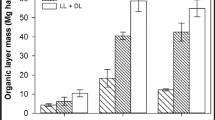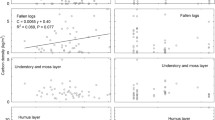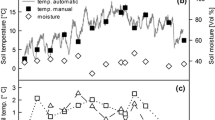Abstract
The impact of land management actions such as prescribed fire remains a key uncertainty in understanding the spatiotemporal patterns of carbon cycling in the Western USA. We therefore quantified carbon exchange and aboveground carbon stocks following a prescribed fire in a mountain big sagebrush ecosystem located in the northern Great Basin, USA. Specifically, we examined the changes in plant functional type, leaf area index, standing aboveground carbon stocks, net ecosystem production (NEP), gross ecosystem production (GEP), and ecosystem-level respiration (Reco) for 2 years before and 7 of 9 years after a prescribed fire. Post-burn GEP and Reco exceeded pre-burn GEP and Reco within 2 years and remained elevated. The variation in GEP and Reco provided no evidence of a large and prolonged net efflux of carbon in the 9 years after the fire. Rather, NEP indicated the site was a sink before and after the fire, with little change in sink strength associated with the burn. Re-sprouting and recruitment of grasses and forbs drove the post-burn increase in GEP. Woody shrub growth was the dominant control on aboveground biomass accumulation after fire, with shrub aboveground biomass reaching ~ 11% of pre-burn biomass after 5 years. The rapid recovery of GEP and the growth of mid-successional shrubs suggest ecosystem-level carbon fluxes and stocks can recover rapidly after fire in mesic mountain big sagebrush ecosystems.








Similar content being viewed by others
References
Baker WL. 2006. Fire and restoration of sagebrush ecosystems. Wildl Soc Bull 34:177.
Balch JK, Bradley BA, D’Antonio CM, Gomez-Dans J. 2013. Introduced annual grass increases regional fire activity across the arid western USA (1980–2009). Glob Chang Biol 19:173–83.
Baldocchi D. 2008. Breathing of the terrestrial biosphere: lessons learned from a global network of carbon dioxide flux measurement systems. Aust J Bot 56:1–26.
Beringer J, Hutley LB, Tapper NJ, Cernusak LA. 2007. Savanna fires and their impact on net ecosystem productivity in North Australia. Glob Chang Biol 13:990–1004.
Bradley BA, Houghton RA, Mustard JF, Hamburg SP. 2006. Invasive grass reduces aboveground carbon stocks in shrublands of the Western US. Glob Chang Biol 12:1815–22.
Burba GG, McDermitt DK, Grelle A, Anderson DJ, Xu L. 2008. Addressing the influence of instrument surface heat exchange on the measurements of CO2 flux from open-path gas analyzers. Glob Change Biol 14:1854–76.
Chapin FS, Matson PA, Mooney HA. 2002. Principles of terrestrial ecosystem ecology. New York: Springer.
Chauvin GM, Flerchinger GN, Link TE, Marks D, Winstral AH, Seyfried MS. 2011. Long-term water balance and conceptual model of a semi-arid mountainous catchment. J Hydrol 400:133–43.
Clark PE, Seyfried MS. 2001. Point sampling for leaf area index in sagebrush-steppe communities. J Range Manag 54:589–94.
Cleary MB, Pendall E, Ewers BE. 2010. Aboveground and belowground carbon pools after fire in mountain big sagebrush steppe. Rangel Ecol Manag 63:187–96.
Cleary MB, Naithani KJ, Ewers BE, Pendall E. 2015. Upscaling CO2 fluxes using leaf, soil and chamber measurements across successional growth stages in a sagebrush steppe ecosystem. J Arid Environ 121:43–51.
D’Antonio CM, Vitousek PM. 1992. Biological invasions by exotic grasses, the grass/fire cycle, global change. Annu Rev Ecol Syst 23:63–87.
Ellsworth LM, Wrobleski DW, Kauffman JB, Reis SA. 2016. Ecosystem resilience is evident 17 years after fire in Wyoming big sagebrush ecosystems. Ecosphere 7(12):1–12.
Finnigan J. 2008. An introduction to flux measurements in difficult conditions. Ecol Appl 18(6):1340–50.
Flerchinger GN, Seyfried MS, Hardegree SP. 2016. Hydrologic response and recovery to prescribed fire and vegetation removal in a small rangeland catchment. Ecohydrology 9:1604–19.
Gilmanov TG, Svejcar TJ, Johnson DA, Angell RE, Saliendra NZ, Wylie BK. 2006. Long-term dynamics of production, respiration, and net CO2 exchange in two sagebrush-steppe ecosystems. Rangel Ecol Manag 59:585–99.
Goulden ML, McMillian AMS, Winston GC, Rocha AV, Manies KL, Harden JW, Bond-Lamberty BP. 2011. Patterns of NPP, GPP, respiration, and NEP during boreal forest succession. Glob Change Biol 17:855–71.
Harden JW, Trumbore SE, Stocks BJ, Hirsch A, Gower ST, O’Neill KP, Kasischke ES. 2000. The role of fire in the boreal carbon budget. Glob Change Biol 6:174–84.
Harmon ME, Bond-Lamberty BP, Tang J, Vargas R. 2011. Heterotrophic respiration in disturbed forests: a review with examples from North America. J Geophys Res Biogeosci 116:G00K04.
Hopkins F, Gonzalez-Meler MA, Flower CE, Lynch DJ, Czimczik C, Tang J, Subke J-A. 2013. Ecosystem-level controls on root-rhizosphere respiration. New Phytol 199:339–51.
Houghton RA, Hackler JL, Lawrence KT. 2000. Changes in terrestrial carbon storage in the United States. 2: the role of fire and fire management. Glob Ecol Biogeogr 9:145–70.
Hui D, Jackson RB. 2005. Geographical and interannual variability in biomass partitioning in grassland ecosystems: a synthesis of field data. New Phytol 169:85–93.
Hurteau MD, Brooks ML. 2011. Short- and long-term effects of fire on carbon in US dry temperate forest systems. Bioscience 61:139–46.
Kwon H, Pendall E, Ewers BE, Cleary M, Naithani K. 2008. Spring drought regulates summer net ecosystem CO2 exchange in a sagebrush-steppe ecosystem. Agric For Meteorol 148:381–91.
Law BE, Sun OJ, Campbell J, Van Tuyl S, Thornton PE. 2003. Changes in carbon storage and fluxes in a chronosequence of ponderosa pine. Glob Change Biol 9:510–24.
Li A, Glenn NF, Olsoy PJ, Mitchell JJ, Shrestha R. 2015. Aboveground biomass estimates of sagebrush using terrestrial and airborne LiDAR data in a dryland ecosystem. Agric For Meteorol 213:138–47.
Miller RF, Chambers JC, Pyke DA, Pierson FB, Williams CJ. 2013. A review of fire effects on vegetation and soils in the Great Basin Region: response and ecological site characteristics. Fort Collins: US Department of Agriculture.
Moncrieff JB, Massheder JM, de Bruin H, Ebers J, Friborg T, Heusinkveld B, Kabat P, Scott S, Soegaard H, Verhoef A. 1997. A system to measure surface fluxes of momentum, sensible heat, water vapor and carbon dioxide. J Hydrol 188–189:589–611.
Moncrieff JB, Clement R, Finnigan J, Meyers T. 2004. Averaging, detrending and filtering of eddy covariance time series. In: Lee X, Massman WJ, Law BE, Eds. Handbook of micrometeorology: a guide for surface flux measurements. Dordrecht: Kluwer. p 7–31.
Obrist D, Delucia EH, Arnone JAIII. 2003. Consequences of wildfire on ecosystem CO2 and water vapour fluxes in the Great Basin. Glob Change Biol 9:563–74.
Odum EP. 1969. The strategy of ecosystem development. Science 164:262–70.
Prater MR, Obrist D, Arnone JAIII, Delucia EH. 2006. Net carbon exchange and evapotranspiration in postfire and intact sagebrush communities in the Great Basin. Oecologia 146:595–607.
Reichstein M, Falge E, Baldocchi D, Papale D, Aubinet M, Berbigier P, Bernhofer C, Buchmann N, Gilmanov T, Granier A, Grünwald T, Havránková K, Ilvesniemi H, Janous D, Knohl A, Laurila T, Lohila A, Loustau D, Matteucci G, Meyers T, Miglietta F, Ourcival J-M, Pumpanen J, Rambal S, Rotenberg E, Sanz M, Tenhunen J, Seufert G, Vaccari F, Vesala T, Yakir D, Valentini R. 2005. On the separation of net ecosystem exchange into assimilation and ecosystem respiration: review and improved algorithm. Glob Change Biol 11:1424–39.
Ruimy A, Jarvis PG, Baldocchi DD, Saugier B. 1995. CO2 fluxes over plant canopies and solar radiation: a review. Adv Ecol Res 26:1–68.
Seyfried MS, Wilcox BP. 2006. Soil water storage and rooting depth: key factors controlling recharge on rangelands. Hydrol Process 20:3261–75.
Slaughter CW, Marks D, Flerchinger GN, Van Vactor SS, Burgess M. 2001. Thirty-five years of research data collection at the Reynolds Creek experimental watershed, Idaho, United States. Water Resour Res 37:2819–23.
Smith TJ, McNamara JP, Flores AN, Gribb MM, Aishlin PS, Benner SG. 2011. Small soil storage capacity limits benefit of winter snowpack to upland vegetation. Hydrol Process 25:3858–65.
Trumbore SE, Czimczik CI. 2008. An uncertain future for soil carbon. Science 321:1455–6.
Voncina A, Ferlan M, Klemen E, Batic F, Vodnik D. 2014. Effects of fire on carbon fluxes of a calcareous grassland. Int J Wildl Fire 23:425–34.
Webb EK, Pearman GI, Leuning R. 1980. Correction of flux measurements for density effects due to heat and water vapor transfer. Q J R Meteorol Soc 106:85–100.
Wilson K, Goldstein A, Falge E, Aubinet M, Baldocchi D, Berbigier P, Bernhofer C, Ceulemans R, Dolman H, Field C, Grelle A, Ibrom A, Law BE, Kowalski A, Meyers T, Moncrieff J, Monson R, Oechel W, Tenhunen J, Valentini R, Verma S. 2002. Energy balance closure at FLUXNET sites. Agric For Meteorol 113:223–43.
Wright CS. 2013. Models for predicting fuel consumption in sagebrush-dominated ecosystems. Rangel Ecol Manag 66:254–66.
Zhang Y, Xu M, Chen H, Adams J. 2009. Global pattern of NPP–GPP ratio derived from MODIS data: effects of ecosystem type, geographical location and climate. Glob Ecol Biogeogr 18:280–90.
Acknowledgements
We thank the Owyhee Field Office and Idaho State Office of the USDI Bureau of Land Management for conducting the prescribed fire within the Upper Sheep Creek catchment. We thank Alex Boehm for his field work and discussions on the Upper Sheep Creek fire and George Azzari for providing the Landsat imagery used in this study. This research was performed in collaboration between the United States Department of Agriculture Agricultural Research Service, Northwest Watershed Research Center in Boise, Idaho, and the landowners within the Reynolds Creek Critical Zone Observatory. This work was supported by the National Science Foundation for the Reynolds Creek Critical Zone Observatory Cooperative agreement under award #NSF EAR 1331872. USDA is an equal opportunity provider and employer.
Author information
Authors and Affiliations
Corresponding author
Rights and permissions
About this article
Cite this article
Fellows, A.W., Flerchinger, G.N., Lohse, K.A. et al. Rapid Recovery of Gross Production and Respiration in a Mesic Mountain Big Sagebrush Ecosystem Following Prescribed Fire. Ecosystems 21, 1283–1294 (2018). https://doi.org/10.1007/s10021-017-0218-9
Received:
Accepted:
Published:
Issue Date:
DOI: https://doi.org/10.1007/s10021-017-0218-9




